Why Can’t You Just Choose Any Ceiling Light?
Unfortunately making a ceiling fixture choice isn’t as easy as simply seeing it online and buying in one click. There are many factors you need to consider before making this decision. The ideal type, width, and fitting of your ceiling light can vary a lot depending on your room size, ceiling height and, most importantly, the objects and surroundings of the desired room.
If this sounds overwhelming, don’t worry. This guide will walk you through everything you need to know, from calculating the right fixture size, to choosing the best fit for each room of the house. By the end, you’ll have all the knowledge you need to shop with confidence and make the perfect fixture choice.
What is a Ceiling Fixture?
Many of you will probably already know this. But for those lighting newbies out there, a “ceiling fixture” is just a fancy way of describing a light that’s mounted to the ceiling. Fixtures typically serve two main purposes:
- Focal Point Light –They serve as the base layer of illumination within a room, filling the space with light and making it feel inviting.
- Decorative Piece –They provide a decorative touch to the space, adding character and elevating the overall aesthetics of your room.
There are many different types of ceiling fixture which are each suited for different room sizes and purposes. This makes fixture choice slightly more complicated, but we’ll cover this later in the article.
What You’ll Need Before Calculating Your Desired Fixture Size
In order to calculate the optimal fixture size, type, and fitting for your space, you’ll have to first take measurements of your room. Here’s what you’ll need:
- Width and length (meters).
- Ceiling height (feet).
- Width, length, and height (inches) of any object directly beneath the fixture.
Note: If the object below the fixture is round, you’ll need to take a measurement of the diameter instead.
How High Should You Hang Your Ceiling Fixture?
Now that you have your measurements, you can work out how much drop your ceiling light should have based on your room’s height. Although these can vary depending on the type of room, here we’ve given some general recommendations for calculating the level of clearance your fixture should have.
- Ceilings up to 8ft in height – Maintain at least 7 feet (2.1 m) of clearance from the floor to the base of the fixture.
- Ceilings higher than 8ft (2.4m) – Our general recommendation is to add between 3-6 inches (8-15cm) to your fixture’s total drop for each additional foot of ceiling height.
Although these recommendations offer a great starting point for choosing your fixture, there is always room to experiment with the level of clearance you leave beneath it. Just remember – the higher a light is hung, the smaller it will look and, vice versa, the lower it’s hung, the larger it will look. Additionally, you need to remember to hang your light high enough so that it doesn’t become a hazard – you don’t want anyone walking into it!

Which Fixture Type Should You Choose?
After working out the ideal amount of clearance space for your fixture, you can now get an idea of the type of fixture that will work best in your chosen room. Before following our recommendations however, it’s best to familiarise yourself with each of the different fixture types we’ve explained here:
Flush Lights – Flush mount lights are designed to sit directly against the ceiling, providing a sleek and seamless look. These are ideal for rooms with lower ceilings as they create the illusion of more space.
Semi-Flush Lights – Semi-flush mount lights hang slightly below the ceiling, typically suspended by a short wire. These fixture types offer a balance between the subtle, clean look of flush lights and the bold effect of hanging pendant lights.
Pendants & Chandeliers– These fixtures are suspended from the ceiling by a long cord, chain, or rod. If you want to make a statement, this is the light you should choose. Ideal for rooms with higher ceilings, they come in various sizes, styles, and shapes, making them a versatile option for many rooms.
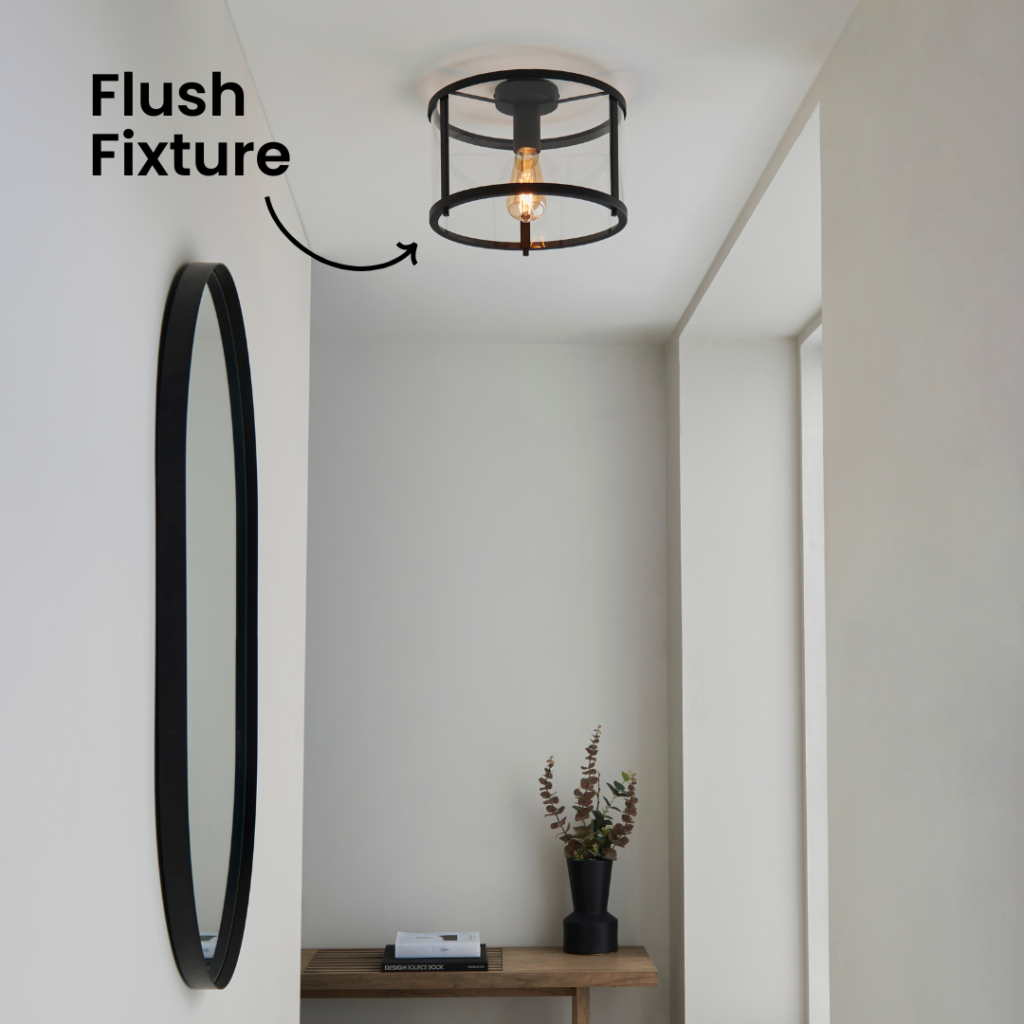
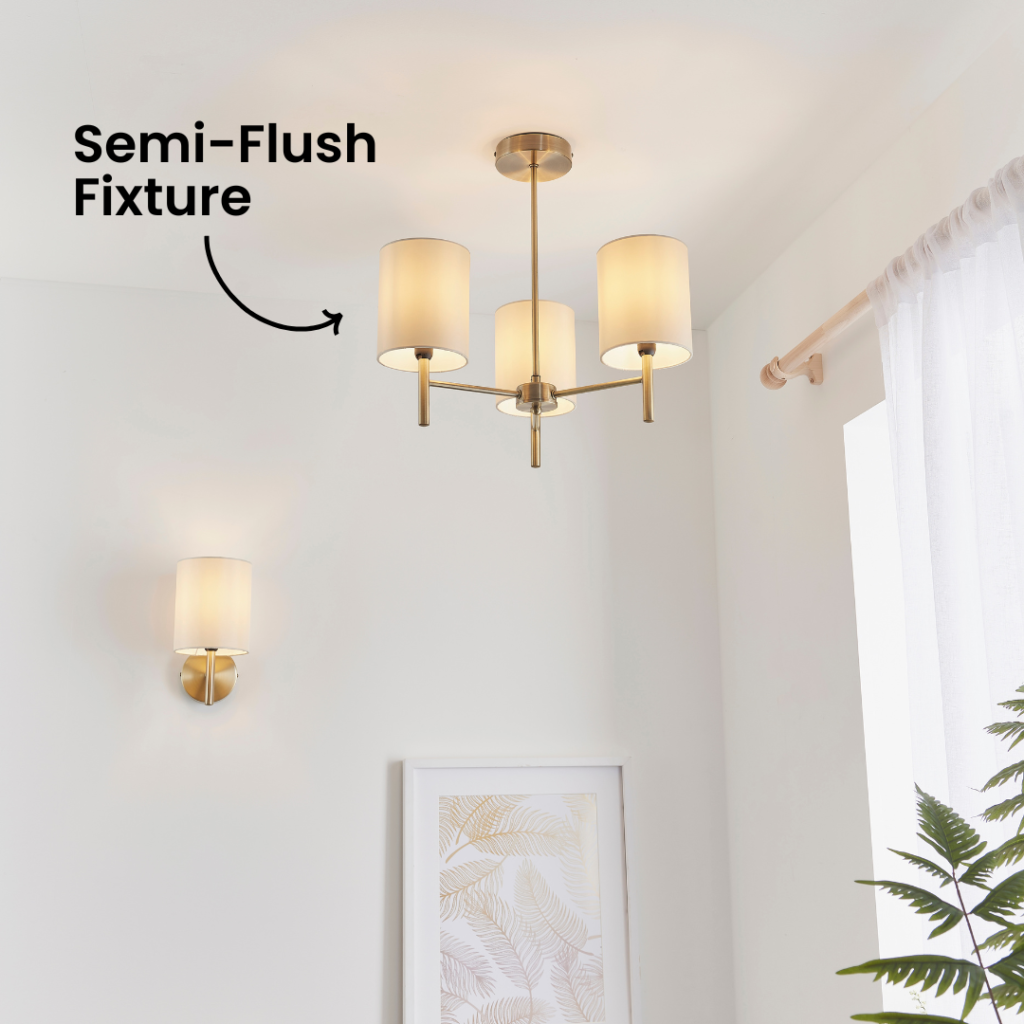
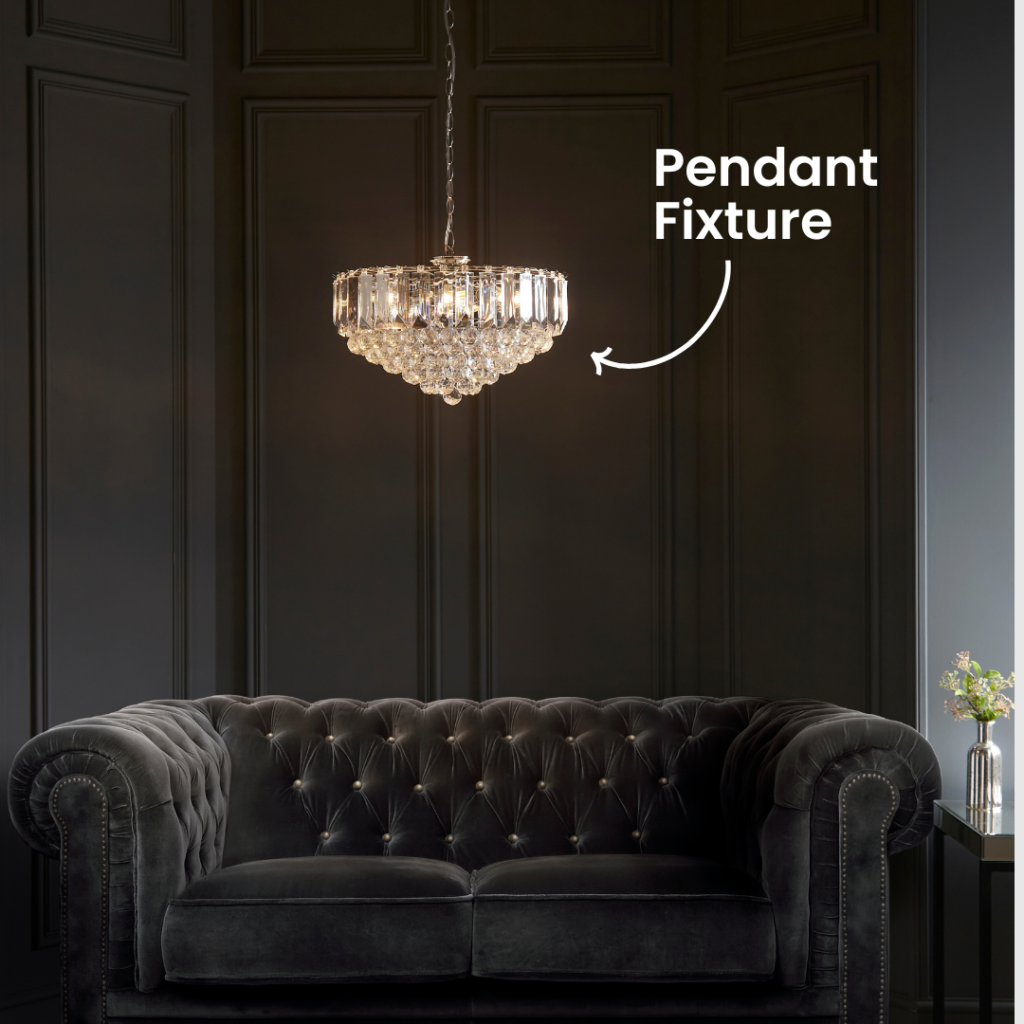
Following these explanations, here is a general guide on when to use each fixture type., including the recommended fixture type and total drop for each of the different ceiling heights:
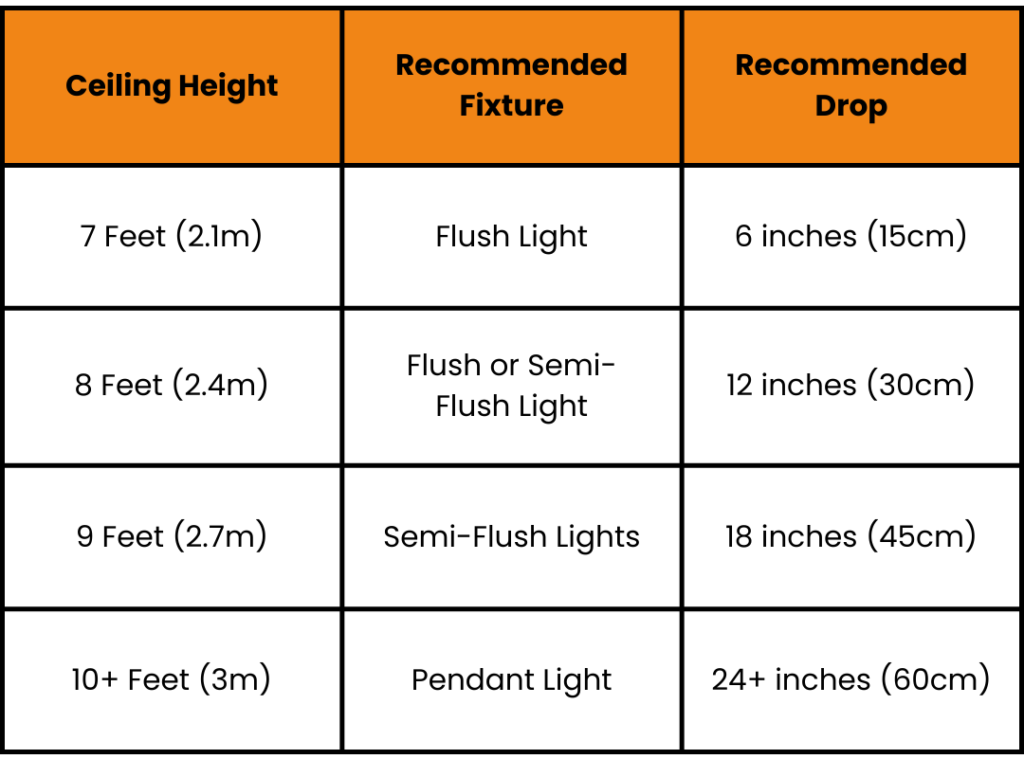
What Size Should Your Fixture Be?
Hopefully, you will now be clear on which fixture type is the best choice for your room and can now start calculating the ideal size of your fixture. This is where those measurements will come in handy. Below are the exact formulas you can use to do this:
- Ideal Fixture Diameter (Inches) = Room Width x Room Length (Meters). For example: A room that measures 6m x 8m would require a light fixture with a 48inch diameter (+-10% depending on your styling preference).
- Ideal Length for Rectangular Fixtures – Use no more than 2/3 the length of the table or island.
- For Fixtures Above a Round Table – The diameter should be 1/2 – 3/4 of the table’s diameter.
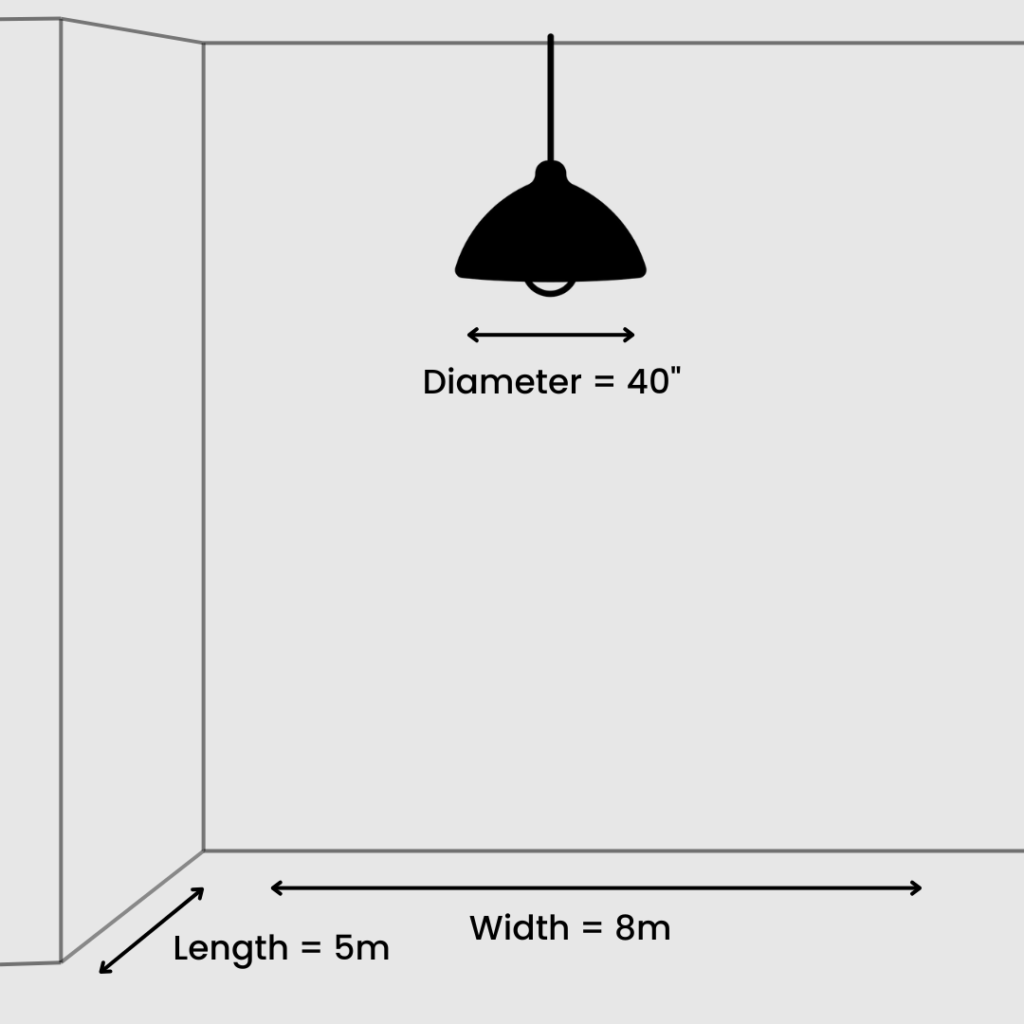
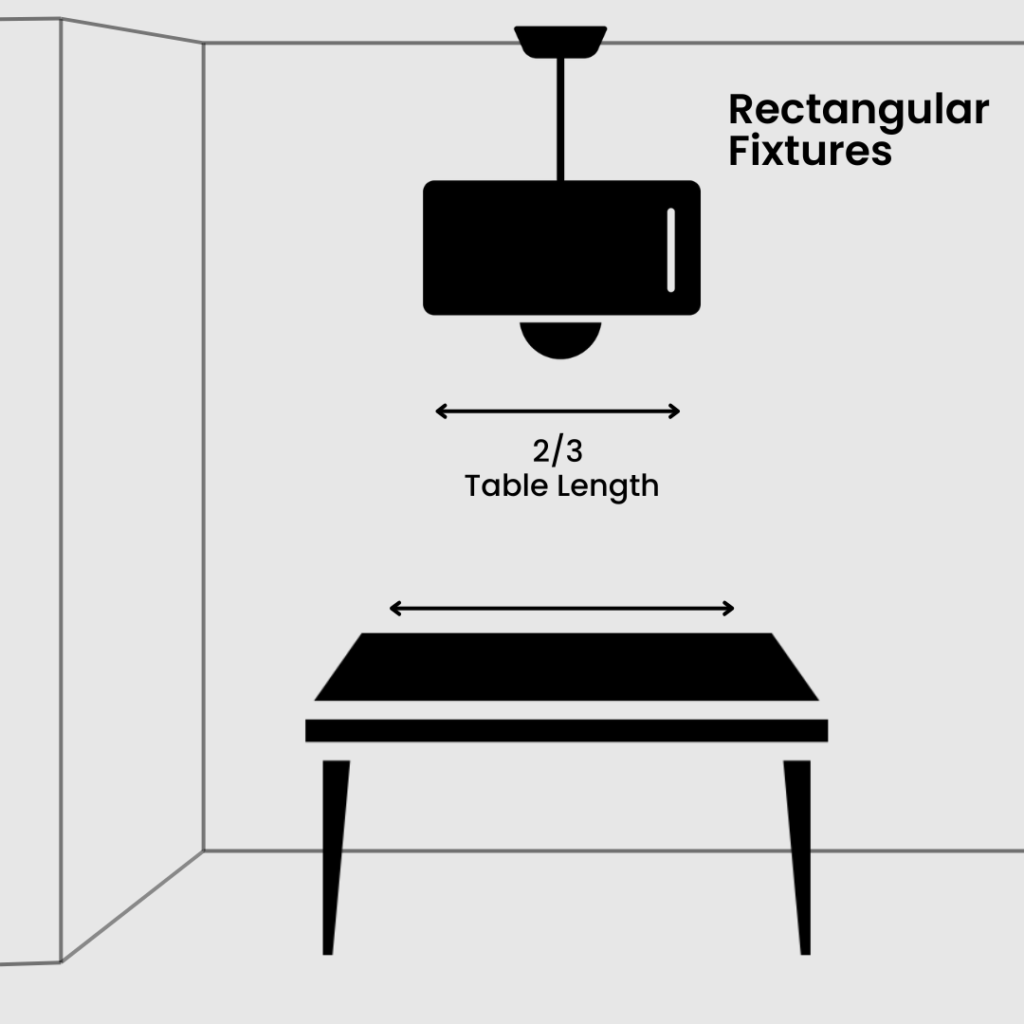
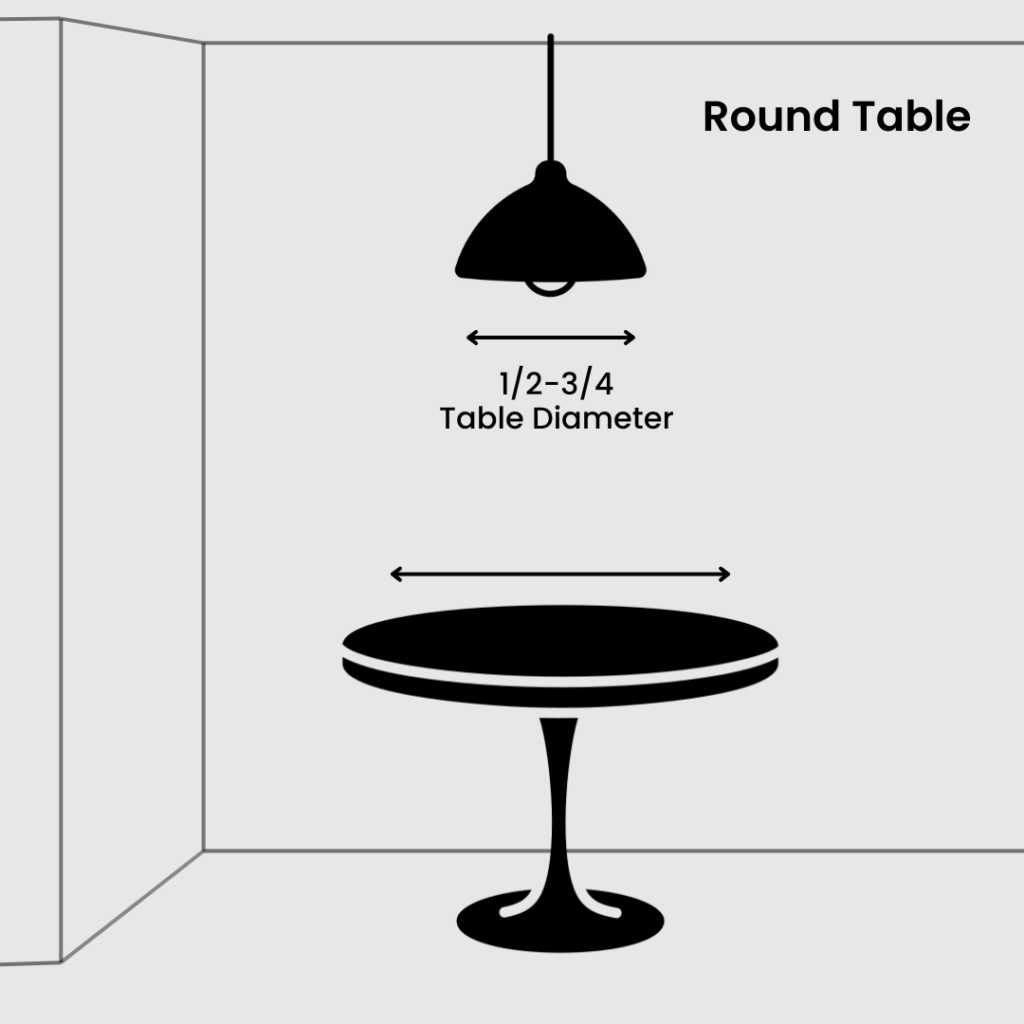
Room-Specific Recommendations
The last thing to consider when choosing the perfect ceiling light is the type of room you want it in. This is very important because room-specific objects such as dining tables, kitchen islands, or narrow hallway walls can affect the optimal placement of your light fixture.
Dining Table
- Hang fixture 30-36 inches above the table surface.
- Fixture width should be 6 inches narrower than the table width
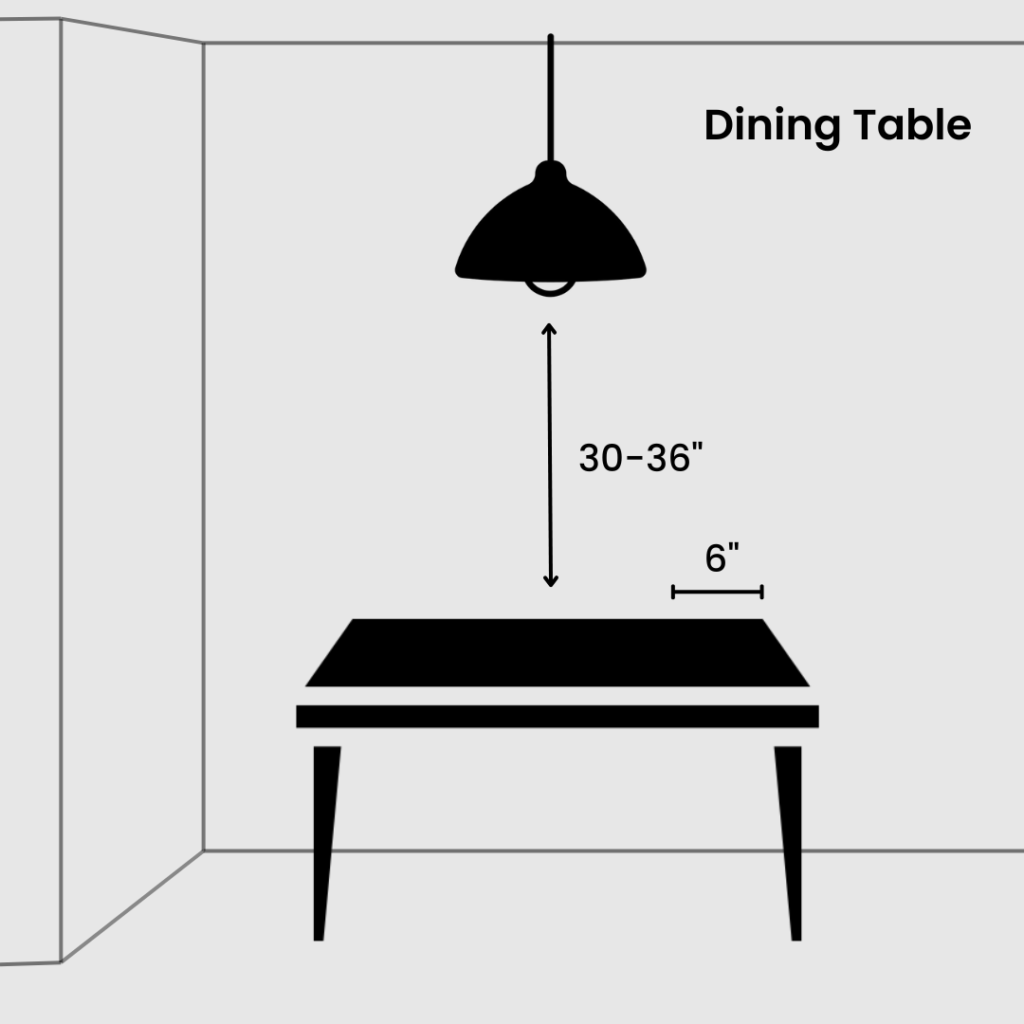
Kitchen Island
- Install 30–36 inches (76–91 cm) above the counter
- Space multiple pendants at a minimum of 30 inches apart for the optimal level of airflow, light spread, and visibility.
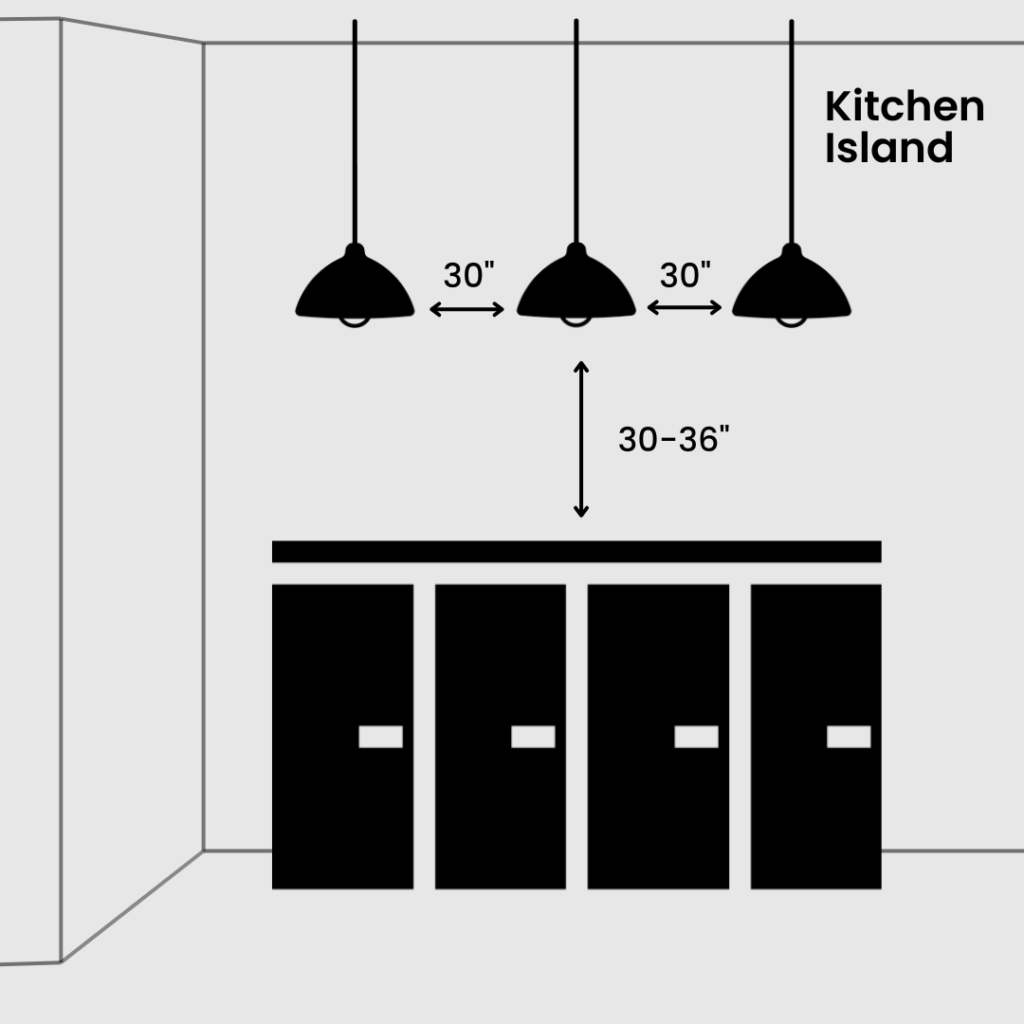
Entry & Hallway Pendant Light Height
- Semi-flush or pendant fixtures in the hallway should have at least 7ft/2.1m clearance from the bottom of the fixture to the floor.
- We also recommend that you leave a radius of around 4ft/2.1m between the light and surrounding walls or other objects to prevent the space from looking too crowded.
- You’ll typically want to opt for a tall and slim fixture in your hallway to maintain this optimal level of spacing.
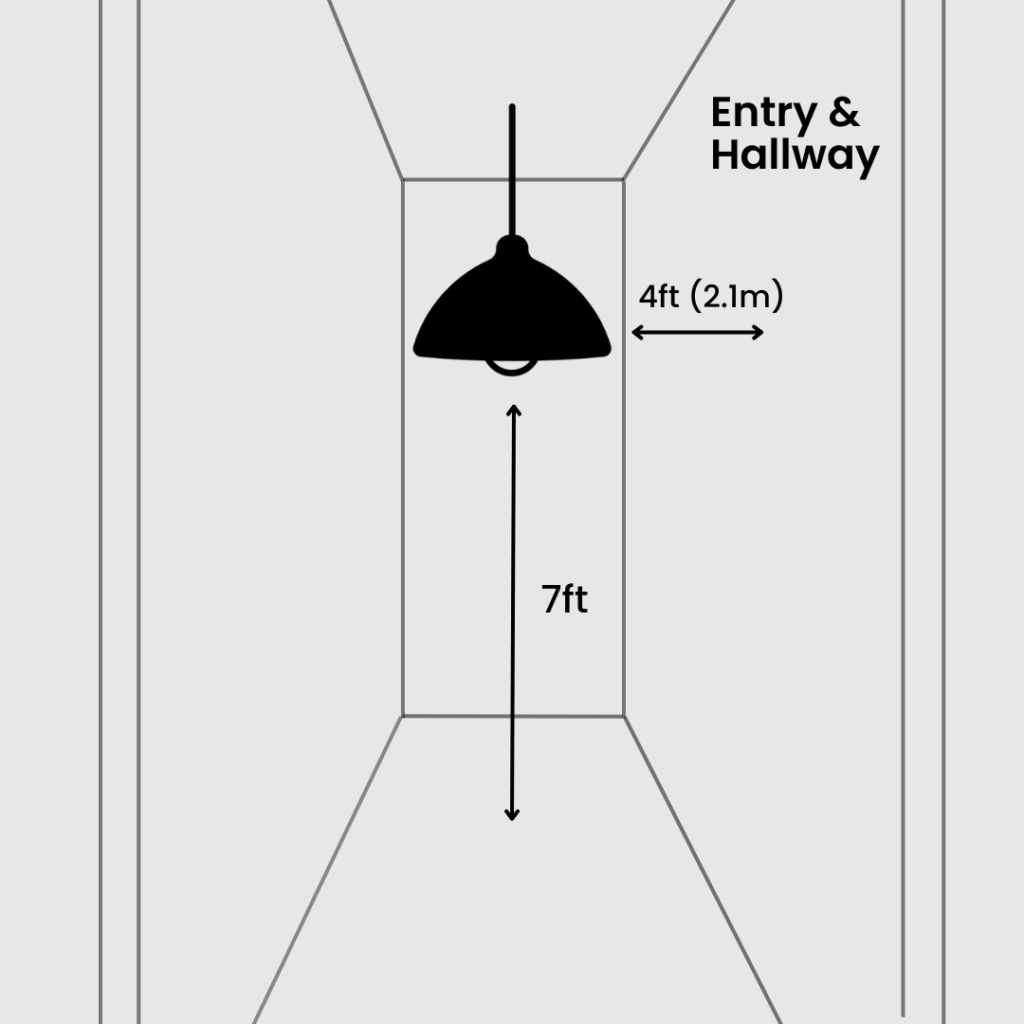
Living room and Bedroom Pendant Light Height
- Just like our standard recommendation, we advise that you leave at least 7ft (2.1m) of clearance with fixtures in living rooms and bedrooms.
- If you’re installing a fixture over a bed then it’s acceptable to fit it slightly lower as there’s no risk of walking into it.
- In bedrooms, it’s also common to hang fixtures directly above bedside tables. In this case, they should hang around 26-32 inches (66-81cm) above the top of the table. This ensures they provide strong lighting levels whilst still leaving space for other items on the table.
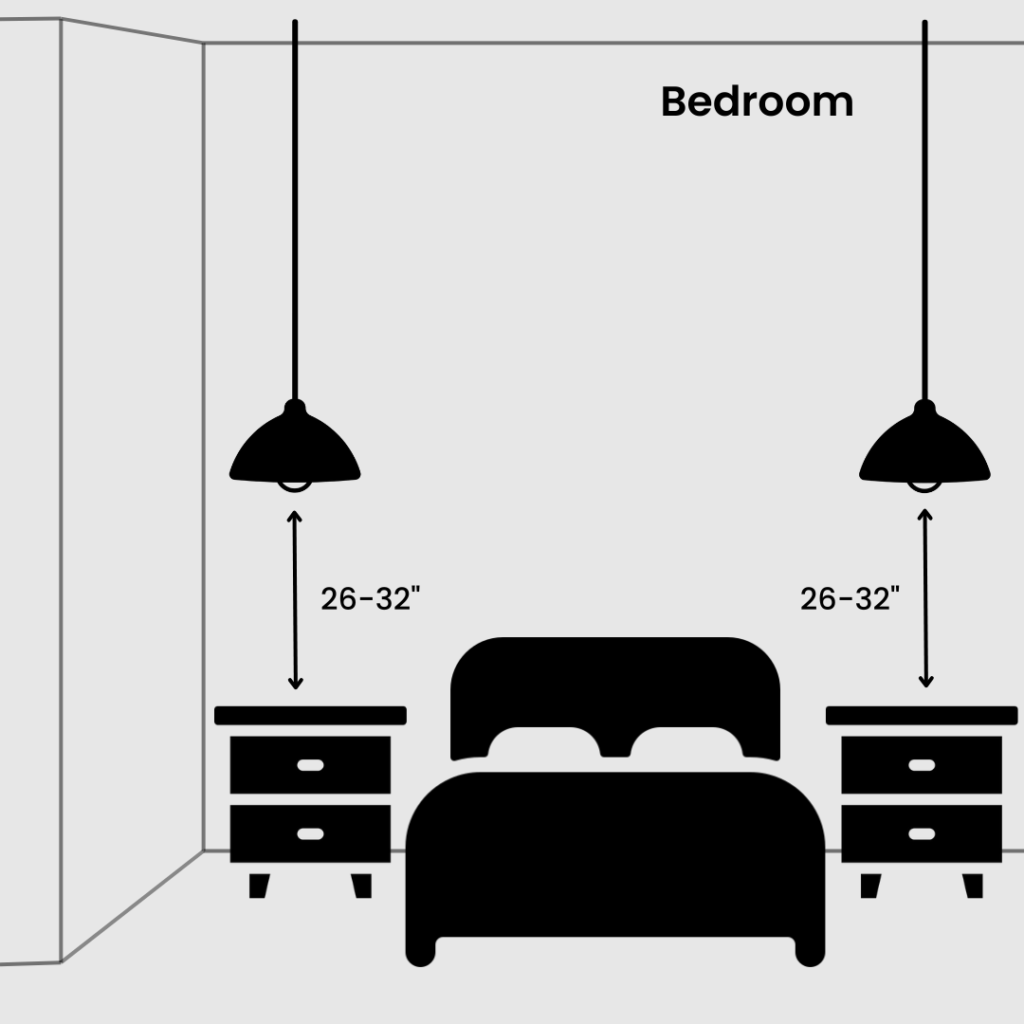
Conclusion
Choosing a ceiling light fixture isn’t always easy, but by considering key factors like room size, ceiling height, and surrounding objects, you can make the perfect choice with confidence.
Start by determining the ideal installation height. For 8ft ceilings, leave at least 7ft of clearance from the floor—if your ceiling is higher, add 3-6 inches of drop per extra foot. For fixtures above tables or islands, maintain 30-36 inches of clearance.
Next, choose the right fixture type for your ceiling height. Flush mounts work best for ceilings 7ft and under, semi-flush lights suit 8-9ft ceilings, and pendant lights shine in spaces with 10ft+ ceilings.
Finally, size your fixture correctly using these simple formulas:
- Standard fixture diameter = Room Width × Room Length (meters)
- Rectangular fixture length = No more than 2/3 of the table or island beneath it
- Round fixture diameter = 1/2 – 3/4 of the table’s diameter
Now, with these guidelines in mind, you can shop confidently, knowing that your fixture choice is the best possible option for your room.
Ready to find the perfect fixture? Browse our stunning collection at nationallighting.co.uk—we’re sure you’ll discover the ideal match for your space.
